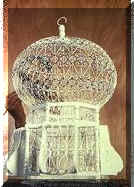 Outside of the official, quality
and price, controlled Artisanat (handicraft) shops, where everything from
carpets to birdcages bears a price tag, and carpets a stamp of origin and
caliber, shopping in Tunisia is definitely an art. Located in the old city
(the Medina), the Souks offer a selection of objects of unsurpassed beauty
and distinction , excellent arts and craft and traditional work. A sharp
eye, nerves of steel, a show of disinterest and a good sense of humor will
make shopping a real pleasure.
Outside of the official, quality
and price, controlled Artisanat (handicraft) shops, where everything from
carpets to birdcages bears a price tag, and carpets a stamp of origin and
caliber, shopping in Tunisia is definitely an art. Located in the old city
(the Medina), the Souks offer a selection of objects of unsurpassed beauty
and distinction , excellent arts and craft and traditional work. A sharp
eye, nerves of steel, a show of disinterest and a good sense of humor will
make shopping a real pleasure.
Inflated prices give both parties the pleasure of bargaining and a golden
opportunity to exhibit your talent as an actor. Start by cutting the offer
in half, then work up to a compromise if you are really interested. The
choice is yours: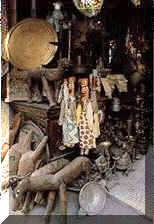
Hand carved olive wood: Salad bowls, kitchen articles, vases, lamps,
bracelets...beautiful , solid
 Authentic
Berber bracelets and necklaces can still be found in the souks.
Authentic
Berber bracelets and necklaces can still be found in the souks.
Bracelets are inclined to be heavy - some ornate some exquisitely modern
in their primitive designs. The price is usually by weight depending on
the silver content and the workmanship. Necklaces are often restrung with
the original silver pieces and glass beads, coins or coral, the latter
adding to the price. A reputable shop will show you the silver stamp ,
although on very old pieces this has sometimes been worn away.  Copies
of original jewelry are more plentiful and often just as beautiful,
lighter weight and easier to wear. The fish, hands of Fatma , triangles,
arches and other designs are charms to ward off the evil eye or insure
fertility. The same symbols are often woven into carpets. Many fine books
on Tunisia explain in detail the ancient significance of these signs.
Copies
of original jewelry are more plentiful and often just as beautiful,
lighter weight and easier to wear. The fish, hands of Fatma , triangles,
arches and other designs are charms to ward off the evil eye or insure
fertility. The same symbols are often woven into carpets. Many fine books
on Tunisia explain in detail the ancient significance of these signs.
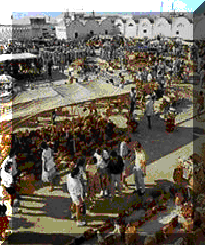
 While
Nabeul (Cap Bon) offers a dizzying selection of pottery and ceramics, many
of these creations can be found in the souks. Ceramic tiles, platters, and
bowls are displayed in every color, hue and design. A careful look will
ensure that the hand painting is well done and the piece intact. The use
and the region dictate the colors as the yellow/green of Jerba, the earth
tones and primitive designs of Sedjane, and the popular blue and white of Nabeul. Guellela
(Jerba) holds the prize for the lovely natural color of
its clay used to create more "practical" pottery, oil and water
jars, bowls and jugs in classical Mediterranean style.
While
Nabeul (Cap Bon) offers a dizzying selection of pottery and ceramics, many
of these creations can be found in the souks. Ceramic tiles, platters, and
bowls are displayed in every color, hue and design. A careful look will
ensure that the hand painting is well done and the piece intact. The use
and the region dictate the colors as the yellow/green of Jerba, the earth
tones and primitive designs of Sedjane, and the popular blue and white of Nabeul. Guellela
(Jerba) holds the prize for the lovely natural color of
its clay used to create more "practical" pottery, oil and water
jars, bowls and jugs in classical Mediterranean style.

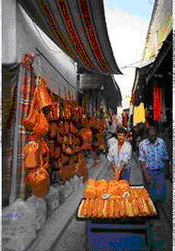
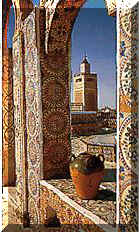 The artisanat shops feature items
from large fruit bowls to small ash trays of enameled red copper in a
beautiful variety of colors and hues.
The artisanat shops feature items
from large fruit bowls to small ash trays of enameled red copper in a
beautiful variety of colors and hues.
 Hats,
pocketbooks, carryalls and hassocks are popular items, in particular the
hassocks in natural leather embossed or painted with traditional patterns
or the ever popular camel. Book covers are beautifully decorated with gilt
and the skill of the traditional leatherworker has in part been
reconverted into making quality leather jackets and coats.
Hats,
pocketbooks, carryalls and hassocks are popular items, in particular the
hassocks in natural leather embossed or painted with traditional patterns
or the ever popular camel. Book covers are beautifully decorated with gilt
and the skill of the traditional leatherworker has in part been
reconverted into making quality leather jackets and coats.
The selections in every category are infinite and rare is the
visitor who can resist such marvels at such reasonable rates. Most carpets
are classified by the number of knots per square meter with silk at the
top of the list with 250,000 and over! Shop owners will unroll one
splendor after another until you find YOUR carpet. The Offices of the
artisanat in most cities sell only quality stamped and inspected carpets
and while there is no bargaining, prices are reasonable and they can
package and send your carpet by plane.
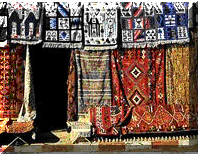
 Pure
bundied wool blankets are greatly appreciated in this day of synthetics and
fine shawls embroidered with traditional designs make unusual and colorful
wall hangings. The colorful ,figurative carpets of Gafsa are often hung on
walls of banks, offices and homes and offer a great variety in size and
price and color
Pure
bundied wool blankets are greatly appreciated in this day of synthetics and
fine shawls embroidered with traditional designs make unusual and colorful
wall hangings. The colorful ,figurative carpets of Gafsa are often hung on
walls of banks, offices and homes and offer a great variety in size and
price and color

![]()